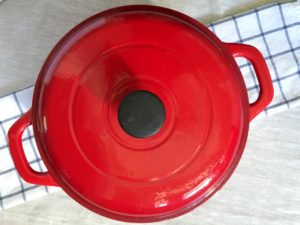
An informal poll has revealed two types of questions about enameled cast iron Dutch ovens:
The first: What are these things, and why would I need one?
The second: I know what they are and would like to own one, but do I really need to fork out $300 dollars for a Le Creuset?
The short answers: Dutch ovens are big, heavy pots that are essential for making winter soups, stews, and braises; and, no, you can get a great one for about $60.
The longer answers:
What is enameled cast iron?
Enameled cast iron is cast iron that has been coated in glass particulate that, when baked at an extremely high temperature, turned into an enamel that bonds to the cast iron.
How is that different from regular cast iron?
It’s pretty! Also: you don’t have to season enameled cast iron, it will never rust, and you can use it to cook acidic foods.
How is that different from a regular, stainless steel pot?
It’s pretty! Also: because it is so thick, enameled cast iron heats slowly and evenly, and can therefore cook food at a low yet consistent temperature over long periods of time. This means you can start a dish on the stove and finish it in the oven.
How is that different from a slow cooker/Crock Pot?
It’s pretty! Also: with many slow cooker recipes, you have two options: either brown things (garlic, onions, spices, or meat) in a separate pot and then add them to the Crock Pot, which creates extra dishes to wash, or forgo the initial browning, and therefore miss out on the flavor that the fond (those flavorful brown bits that get stuck to the bottom of the pot) lends to the dish.
Okay, enough with the technical differences. What can I cook in this thing?
My enameled cast iron Dutch oven is the workhorse of my fall and winter kitchen. I use it to braise meats, making everything from a showy lamb shank tagine to crispy pork carnitas to the coziest three-meat ragù. I use it to make winter stews–vego or with meat–that need a long simmer on the stovetop (since the Dutch oven cooks everything slowly, you can add ingredients and layer flavors in a way that is hard to do in a regular stockpot). I’ve used it to simmer Slovenian-style stuffed cabbage, like my mom’s mom used to do. You can even use it to bake bread.
Alright, I’m sold. But which one should I buy? I looked into a Le Creuset and it cost 300 dollars.
May I recommend: the Tramontina 6.5 quart enameled cast iron Dutch oven.
Why do you recommend that one?
Cost: When I ordered mine, it cost $60—20 percent of the price of a comparably-sized Le Creuset.
Size: 6.5 quarts is enough to make a hefty double or triple recipe of soup, but not so big that it takes up the whole oven during a long braise. (I can still, say, bake some fingerling potatoes on a rack below the Dutch oven.)
Shape: Round is better than oval, because a round Dutch oven sits evenly on a burner, whereas an oval one hangs off the sides of the burner, which makes the Dutch oven heat unevenly.
Performance: The Tramontina model heats evenly. It has also endured considerable heavy use (even abuse) without any chipping in the enamel.
Also: Cooks Illustrated recommended it.
Any tips on use or cleaning?
1. Never heat the Dutch oven while it is dry or empty–always have a bit of oil or water in the bottom.
2. Clean the Dutch oven with soap and a sponge–never an abrasive cleanser.
3. Use the Dutch oven only over low or medium heat–never high heat. Don’t worry: it heats slower, but because of the heat retaining qualities of cast iron, it will still get hot enough to sear meat. (I do a bit of chopping/prep while it heats, so that I don’t lose time.)
4. Use only wood or plastic utensils (metal can scratch the enamel).
5. Once the Dutch oven is hot, use oven mitts to touch any part of the pot, including the handles.
Leave a Reply